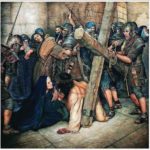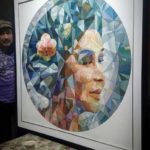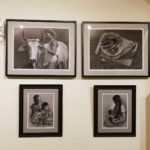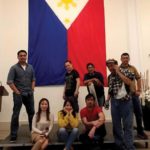“We used to be able to manage with the belief that the physical art object was the end product of art, and the process of art was everything that went into achieving it. In this view, the artist, the visionary capacity, reaches into a realm less accessible to normal perception and, through acquired technique, translates vision into a finished work of art – the art object itself. As part of that process, the artist communicates inwardly at first. The art of creation is a learning process for the artist, as both vision and techniques are honed by the production of each art object. The process is one of considering, refining, learning – in an exchange with the self. As the ever-quotable Picasso said, ‘I am always doing that which I cannot do, in order that I may learn how to do it.’” – Hugh Moss, “The Art of Understanding Art: A New Perspective” (2015).
“We were also taught to navigate the seas around us by men of wisdom and talent, who had sailed far, to the lands in the north where there was ice in the mountains, to the south, and the far countries which were ruled by leaders with skins fairer than others. And then, there were the techniques of war to be learned as well, but I was never meant to be a warrior for I was meant, I suppose, to be a sailor, a navigator, having memorized as I did the landfall of different islands, different nations, the coming of the good winds, of the cruel seas, whipped by typhoons. I learned them all, for we have always been a nation of traders as well and the craft of the sailor is hammered into us as a matter of course, even before we learned how to sail.” – F. Sionil Jose, “Viajero – A Filipino Novel,” (1998).
Ronald Cortez was born in Lucban, Quezon when at two months old, he lost his father to an aneurysm to be singlehandedly raised by his mother, Nanie Ratio Cortez, who earned enough for rent, food and school fees, but no luxury like toys for Cortez.
He possessed an innate interest for the arts and pencils and brown paper bags became his sketchpad where he would doodle away the “stored mountains in his imagination.” When his mom went overseas, he started drawing portraits at 10 years old.
He watched commercial artists do charcoal drawings at shopping malls for inspiration and saved his allowance to buy art materials. In high school, his cousin asked Cortez to paint a portrait of his girlfriend. His cousin got him his first set of oil paints and it was then that he decided to be a painter. When he went to college at Southern Luzon Polytechnic, his mother persuaded him to be a viajero, a seaman. Yet, being a viajero was not his dream. He completed his seaman course to comply with his mother’s wishes.
But, he satisfied his artistic hunger by browsing through books at the National Bookstore in Avenida. At an art store in Mandaluyong, he then met his first mentor, Loreto Racuya, an artist who persuaded him to follow his dream. Racuya introduced him to the owner of an art supply store and shared insights about “the Parable of the Talents” which became Cortez’s guiding principles in life and his art.
First: one must share his God-given talent with mankind. Second: that God would provide for what he needs to further his talents. Third: that each individual is endowed with their own set of talents but one can focus on a particular one and still be able to use other talents. Fourth: whatever we do should glorify God, who provides us with these talents. Fifth: we will be held accountable for our work.
Cortez’s paintings were introduced to me through a friend’s iPhone. They were lifelike, seemingly able to breathe on their own. In his paintings, fish appear to swim and glide, much like sailors who navigate the seas; tomatoes seem so ripe that you would want to slice them; a salted egg with a distinct-looking yolk and a hint of oil to it; and the Philippine peso is realistically portrayed.
“We overlook so many things because of our greediness. Masyado tayong fixated sa ibang bagay (We are too fixated on things). Lahat ng ito – paintings I credit to the One who gave me the talent and [it is] important for me to share my talent, to the Glory of God, even without my signature,” he said.
His exhibited paintings at the Viajeros: “The Farmer, Still Life, “Mag-ina,” “Helping Hands,” “Isda at Kamatis (series iv and v)” presented the daily realities of a farmworker. He intended their lives to be elevated, e.g., the ordinary “Tinapa 1 and 2,” masterfully rendered in pastel of bluish gray, white, red and brown, quite worthy of an art enthusiast’s attention, perhaps by someone like Hugh Moss whom I quoted above.
In contrast, he rendered four charcoal paintings: “Mag-ina” depicting a breastfeeding mother; “The Farmer” — showing a farmer and his carabao, “Helping Hands” — a grandmother and her granddaughter mending a dress with the child attempting to thread a needle, and “Isda at Kamatis” — a plate of fresh mackerel and tomatoes. These paintings created ‘dignity of labor’ impressions, illustrating the ordinary lives of farmers and low-income workers.
“Minsan, nasisipa lang (at times you just get kicked around),” yet his paintings captured the realism of subjects in action. Like the ripped upper arms of the farmworker, which matched the shield’s curvature, coming from two horns of the water buffalo or carabao that grow to join as one base. One also notices the formation of the mother’s arms as she breastfed, coddling her baby and her long hair joining the curvature as if one sees the formation of a sling holding the baby safely.
“Pag nakatungo ka – marami kang makikitang simpleng bagay, pero pag nakatingala ka, parang iyong striving for greater things, greater expectations. I am not after that. One can see how greed creates chaos in the world, pero kung konti lang ang mayroon tayo, nakapagpasaya sa atin ay simpleng bagay lang. The world will be much happier and peaceful (If you look down, you get to notice simple things, but if you are looking up, it appears you are striving…but if you are content with what little you have, even the simplest things can bring you joy).”
Cortez joined 15 painters, whose works were displayed at the Philippine Consulate June 22 to July 6, 2018, as part of Bringing Filipino Art to the World’s initiative, to San Francisco, Manila, New York and Texas. Close to a hundred folks attended their opening night, themed “Viajeros” (Voyagers). The participating artists included Emil Bauto, Xander Caceta, Raul Roco, Jr., Apolinario Follos, Maria Pureza Escano, Jane Ebarle, Ina Jardiolin, Coco Torre, Oying Madrilejos, Jesse Marinas, Danny Doce, Jun Impas, Jun Aquino, Orlando Distor, Ernesto Veroya and Ronald Cortez.
The exhibit is a full circle moment for Cortez who considered being a seaman because of his mom’s persuasions, yet might it be that God had a different plan for him, to be a painter whose works are on exhibit at Viajeros?
At New York’s Philippine Consulate, he joined 31 artists whose paintings were on display as part of the Society of Philippine – American Artists’ 25th-anniversary exhibit held Oct. 16 to 26, 2018. His painting was called “Pamana.”
“Yes, Tita Prosy, that is our family portrait. I made it for my wife. I’m observing my son making drawings while my wife is watching. It is an oil painting on canvas, 24 x 18, “ he continued.
The ‘coming of the good winds’: Mentoring (a relationship of respect and caring)
“Natutulog ako kasama si Mama Mary (I sleep with Mama Mary). Everywhere I travel the statue is with me. This statue has been with me since I was 14 years old as [the] leader of the block rosary. I pray to her every night, siya lahat ang nagbibigay ng grasya kahit nasaan ako (She is the source of grace wherever I go). My friends call me Milagrosa,“ Mariñas told me over a Facebook Messenger’s interview on October 15, 2018. Mariñas has now moved to the Philippines.
“Why Milagrosa?”
Mariñas was born in the squatters area with four siblings. When he was little, he recalled being told by relatives that he would scratch his face until it got bloodied. But, while he slept, the wounds got healed, “Wala daw sugat ang mukha ko paggising ko. Nawawala. Kasi, kinakamot ko ang mukha ko hanggang magdugo (I woke up with no wounds on my face. They would banish, even though I would scratch my face until my face bled).”
He got a degree in fine arts as a painting major from the University of Santo Tomas. Following the firing of his parents by Mr. Marcos, he immigrated to the U.S. in 1973, as the eldest of 12 siblings, intending to give them a fresh start in the U.S. He worked at Western Knapp Engineering Co., which specialized in plant designs and oil platforms, as the senior mechanics principal designer (the highest title given to a non-engineer) under an umbrella engineering group, Kvaerner, based in Norway. He worked for 35 years and qualified for disability retirement, following a spinal deterioration.
While recuperating from his spinal surgery in Manteca, he felt the energy, the “soul of a wall,” and told his wife, “I will soon have my mural there.” His wife doubted it would occur as he just had a spinal operation.
He resumed painting again at 58 years old and started with an abstract painting such that one might even see the image of Nativity, on closer look.
Nine years later, he is more prolific as a painter and has produced 40 paintings in a span of a decade.
He joined the “2007 Biannual Public Art and Mural Symposium held in Manteca, [California]. Eight North American artists were asked to paint 5ft X 8ft murals that depicted the bounty of the Central Valley. These eight murals are now hanging in the Manteca Senior Center at 295 Cherry Lane.”
His mural, “The Harvest Continues,” won first place. It was described as exceptionally detailed as it shows the grapes being prepared for crushing. The crushed product is then made into juice or fermented into wine.
The process of painting started with: “he met with the local grower, John Leandro at his property to research and design his mural. Although Jessie’s dog was not in the original design, Promise insisted on being included, ” based on the association’s website. Promise faithfully stayed by Jessie’s side as he painted through the night that the final mural included the dog, including individual paint lines for the fur,” as described in the website.
When he endeavored to paint adopting a different technique, he shared the dialogue he had in a dream with his spiritual Mentor.
“What would you like to do?”
“I want to paint again, but I want to paint my way, instead of a brush. I want to show my suffering from my spinal condition.”
“Didn’t you know that guys nailed me to the cross – why not use nails?”
Since then, his paintings have used oil-dipped nails, with clearly defined lines and skin textures.
He painted a mural, Eagle Heart, with soldiers in a group hug, representing five different wars: World War I, World War II, Korean War, Vietnam War, and War against Iraq and Afghanistan.
This was eventually purchased by the Manteca Mural Society and is still on display, as he predicted to his wife, “My mural will hang there.” Later, he discovered that wall used to be a memorial wall, only it had been painted over. It is simply giving back to the “soul of that wall,” he added.
Manteca Ripon Bulletin reported on April 12, 2011 that “Jessie Marinas – a man who found strength in his “artistic soul” after a series of spinal injuries triggered a number of painful surgeries – is being inducted into the Manteca Hall of Fame.”
Mariñas has just finished painting Imeldific, a stunning portrait of Imelda Marcos surrounded by diamonds, with her face inside a diamond.
In the artistic world, there is a belief that art is a powerful vehicle for both its surface appeal and its implied underlying nature.
Admittedly, the painter Mariñas succeeded in showing the subject’s beauty, the so-called surface appeal, “but I also sense her sadness, even if surrounded by all of [this] brilliance,” Mariñas added.
In the process of doing Imeldific, Danny Doce became the first student at Jessie Mariñas School of Arts in the Philippines.
Mariñas and Doce met for the first time as part of the “Viajeros” exhibit, which created a mentoring opportunity between Mariñas, the mentor and Doce, the mentee.
Mariñas picked up Doce from the airport, outbound from the Philippines. Doce believes God’s provision allowed him to make this trip to San Francisco. He relied on the prayers of his pastor and fellow church members’ prayers and later was introduced to a sponsor. A few days before the exhibit, the sponsor bought him an airline ticket and inside was $500 as his allowance.
But, Doce had to find lodging.
Mariñas offered lodging for Doce in Manteca, a trek of two hours and 23 minutes by car, 74 miles away. Together they went back to Manteca for rest, and commuted daily, 148 miles round trip, for the installation, opening and take-down of the exhibit. That meant staying till dawn to work on their installations, drive to Manteca and back again to San Francisco.
After, they went to the Golden Gate Bridge, a place of inspiration. There, they sat and drew all day.
In the Philippines, Doce painted with Mariñas. Together they attempted new levels of excellence in portrait painting with three–dimensional effect as if the subjects are coming out of the canvas.
Doce, in an interview on Oct. 14, 2018 via social media, described how a village of generous Filipinos helped him achieve his dream to be in San Francisco.
“Imagine for a month and a week in Manteca, I did not spend a dime, and that is due to the immense generosity of the Mariñas couple. I am grateful for what they did,” he said, adding that even today, Mariñas continues to be his mentor.
“What lesson did you learn,” I asked?
To which he answered, “That I need to focus, that I have to level up, that I am competing not against any other painter, but my former self, and my last painting.”
It is from this rigorous exchange of what can be finessed, what lines can be drawn, what color can be used, that a magnificent painting of Doce came to be, “Nasaan Ka?” It is a portrait of a beautiful woman, almost ephemeral, her facial expressions reaching upward with vibrant red roses surrounding her face, and her face as if coming out of tree branches. Soon after Doce posted it on Facebook, he sold the painting.
Mentoring is described as a relationship between equals, where there is respect and caring between the two. The ancillary effect to their relationship – both have improved from interacting with one another.
After trying to finish the Spoliarium study for a decade, the original was painted by Juan Luna, a Filipino painter in 1884, Mariñas conscientiously studied it at the National Museum of the Philippines and finally, he has just completed it recently.
Mentoring has its inexplicable rewards, from master mentor to mentee and vice-versa. To whom much is given, much is expected, yet, as one gives, he too gets much in return, as well.
* * *
Prosy Abarquez-Delacruz, J.D. writes a weekly column for Asian Journal, called “Rhizomes.” She has been writing for AJ Press for 10 years. She also contributes to Balikbayan Magazine. Her training and experiences are in science, food technology, law and community volunteerism for 4 decades. She holds a B.S. degree from the University of the Philippines, a law degree from Whittier College School of Law in California and a certificate on 21st Century Leadership from Harvard’s Kennedy School of Government. She has been a participant in NVM Writing Workshops taught by Prof. Peter Bacho for 4 years and Prof. Russell Leong. She has travelled to France, Holland, Belgium, Japan, Costa Rica, Mexico and over 22 national parks in the US, in her pursuit of love for nature and the arts.











